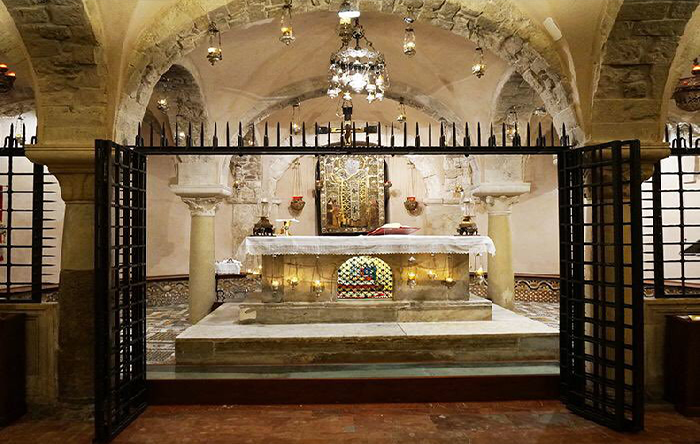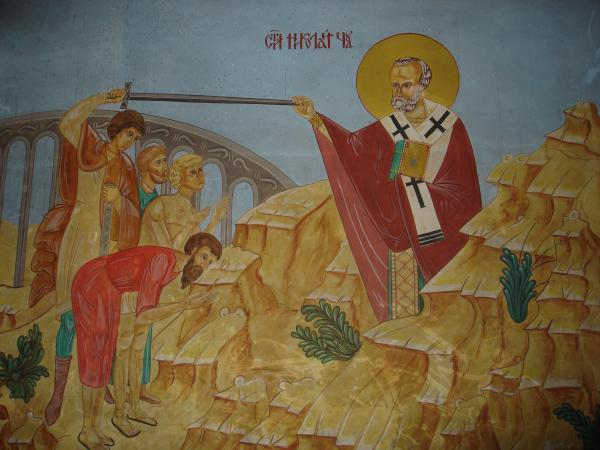Nicholas was the only son of famous and rich parents Teofan and Nona. He was born in the Asia Minor region of Lycia, in the city of Patara around 270. Immediately after his birth in St. Nicholas, as the legend testifies, the future miracle worker could be recognized because during the baptism he could stand on his own two feet without anyone’s help. At his baptism, he was given the name Nicholas, which means the winner of the people.
Uncle Nicholas, the bishop of Patar, taught him the spiritual life. They became monks together in the monastery of New Zion. After the death of his parents, he sold the entire property and distributed the money to the poor. He was a priest in his hometown for a while, and then he retired to solitude. Christians believe that the voice of the Lord appeared to him and said to him: “Nicholas, go to the people for a feat if you want to be crowned by me.”
Then he left hermit life and went to the people. He was elected archbishop of the city of Myra in Lycia (the area of today’s Turkey). During the reign of the emperors Diocletian and Maximilian and during the persecution and torture of Christians, he was imprisoned in a dungeon, but even there he did not stop preaching and spreading Christianity.
He attended the First Ecumenical Council in Nicaea, but because he slapped the Alexandrian priest Arius, accused of heresy, he was removed from the council and he was forbidden to continue. They allowed him to be present at the council again only when the voice of Jesus Christ and the Most Holy Mother of God appeared through the elected hierarchs, that a great injustice had been done to Saint Nicholas. Many stories have been written about his merciful deeds, including the story of the three daughters.
The story of three daughters
A respectable and wealthy man lived in Patara, with three very beautiful daughters. He was in trouble to lose all his wealth and suddenly became impoverished. In despair and misery, having nothing to eat or anything to wear, a man decides to turn his house into a brothel, and his daughters into prostitutes. Hearing about the extreme misery of that man and his evil intention, Saint Nicholas decided to help him. Respecting the words of the Gospel that alms should not be done in front of people, as much because of advertising, but also because of the desire not to shame a man who falls into misery out of great wealth, St. Nicholas decided to secretly help him.
One night, Saint Nicholas took a large bag of gold and quietly threw it through the window into the house of the unhappy father. Finding a bag of gold coins the next day, overjoyed and amazed, and unable to explain where it came from, the man attributed this unexpected charity to God’s providence. Praising the Lord, he decided to give all the gold he received as a dowry to his eldest daughter.
Soon she married happily, and St. Nicholas, hearing that the poor man had acted according to his wishes and saved his daughter from sin by legal marriage, decided to do the same mercy to another daughter. And not much time passed, and the father married another daughter in the same way.
Relying on God and in the firm hope that he will take care of his third daughter, the man decides to find out when God sends the secret benefactor with gold. One night, watching by the window, the man heard the clatter of the inserted money and started running after the unknown, recognized in him a saint and deliverer known to all. The overjoyed father fell at his feet, began to kiss them and say words of praise, but St. Nicholas lifted him from the ground and made him swear that, while he was alive, he should not tell anyone what had happened to him.
Miracle worker and protector
Christians believe that St. Nicholas is a miracle worker and that many miracles happen from his miraculous relics from which holy myrrh constantly erupts, which heals the sick. This saint saved stranded and lost ships, so he is considered the protector of sailors. That is why sailors often call him in dangerous situations or shipwrecks.
On December the 19th, all ships, wherever they were, dropped their anchors and rested until the next day, giving glory to this saint. On the eve of the holiday, boats often stop while sailors pray to the saint and then continue their journey. With his miraculous powers, St. Nicholas helps everyone who turns to him for help in illness, infirmity and mental suffering. With the help of his prayer, sight is restored to the blind, the lame walk, and the sense of hearing is restored to the deaf.
Icon of Saint Nicholas on ships
Once upon a time, all Christian ships had the icon of Saint Nicholas, and He was especially celebrated along the Adriatic and Mediterranean Seas, where it was customary not to set sail on the day dedicated to Him, and for ships to anchor on the high seas and continue sailing the next day. Saint Nicholas died on Friday, December 19 in the year 343, and he was buried in the Cathedral Church in Myra.
His body rested there for more than six centuries, and Christians came to his grave and brought their sick. Among them were the Old Slavs from the river Don, which explains why St. Nicholas is so respected by the Serbs. The Seljuk Turks defeated the Byzantine army on August 26, 1071, so that Byzantium temporarily lost control over much of Asia Minor. This area was returned to Byzantium only during the reign of Alexius I Comnenus (reigned 1081-1118), but it still remained under the attacks of the Turks.

Christians believe that in this confusion, St. Nicholas appeared in a miraculous dream to an honorable priest from Bari and ordered that his relics be transferred to Bari (Italy), which at that time was an Orthodox city and under an Orthodox patriarch. The relics arrived in Bari on May 9, 1087. As a memorial to the transfer of the relics of St. Nicholas, the Church has established another holiday related to it – the transfer of the relics of St. Nicholas. It is celebrated on May 9. For many families, this is a “Slava” patron saint’s celebration. It is popularly called Young Saint Nicholas and Summer Saint Nicholas, Nikolitse.
Iconography
The icons of St. Nicholas usually depict Jesus Christ with the Gospel in his hands on one side, and the Most Holy Mother of God with the hierarch’s omophorion on her hands on the other. This has a double historical significance. In the first case, it means calling Nikolai to the hierarch’s service, and in the second, it represents a justification for punishment due to the conflict with Arius.

